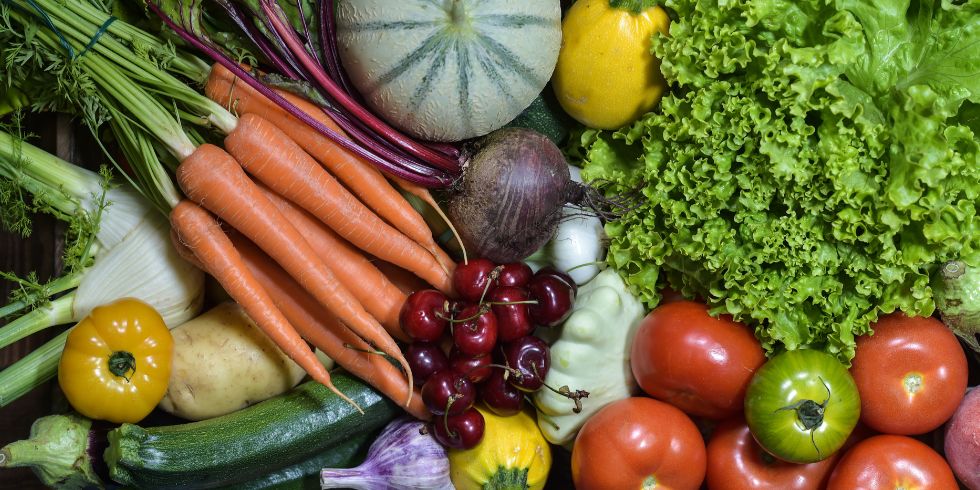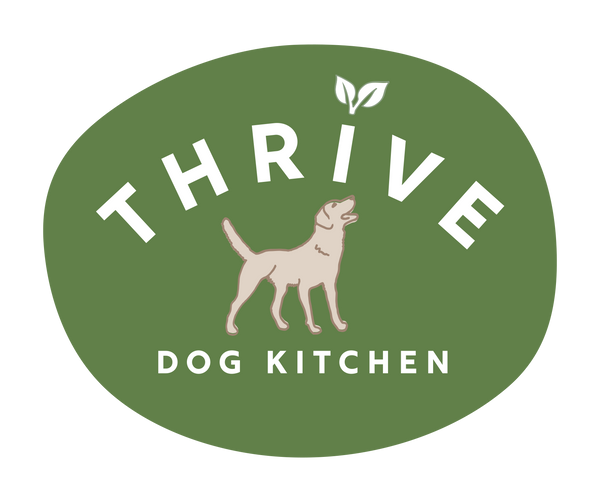
How to Add Fruits and Vegetables to Your Dog's Diet
Share
Feeding dogs fruits and vegetables can bring up strong feelings for many dog parents. At one end of the spectrum are dog parents feeding our carnivorous companions a vegan based diet. And at the other end are dog parents feeding only meat and bones.
While dogs do not require carbohydrates to survive, many will thrive and enjoy a bit of fruit and vegetables added to their diet. At Thrive Dog Kitchen we fully support and encourage dog parents to incorporate plant matter into their dog’s meal regularly because of the many health benefits, including:
- Packed with vitamins and minerals
- Cancer-fighting
- Repairs damaged DNA cells
- Full of antioxidants and phytonutrients
- Protects against heart disease
- Excellent source of both soluble and insoluble fibre
- Builds and protects the microbiome
The key is to find a balance that is suitable for your dog. The quality of the fruits and vegetables is more important than the quantity. Incorporating fresh veggies and fruit will support your dog’s health.
10 Tips to Get You Started
Whether you regularly feed fruits and vegetables to your dog or it is a new thing for you, we know how to get your dog to eat fruits and vegetables. Here are our top tips to help transition your dog into a plant loving carnivore.
- No more than 25% of your dog’s daily intake should be vegetables and fruit. The suggested vegetable to fruit ratio is 4:1 due to the high sugar content of fruits. The amount your dog consumes can range between 5% to 25%. It all depends on you and your dog.
- Puree, juice or blend for optimal digestion - Your dog's digestive tract is shorter than yours, which means that they do not absorb nutrients from fruits and vegetables the same way we do. To help your dog reap the benefits of these nutritional additions, puree, blend or juice them to break down their cell walls.
- Feed fermented vegetables - Store bought or homemade is an excellent source of probiotics for your dog to support a healthy gut, which helps boost your dog’s immune system. They are a great source for antioxidants, phytonutrients and fibres, which help your dog thrive. Fermenting vegetables makes the nutrients more bioavailable for your dog. Plus, they are easier to digest, just make sure they’re onion-free.
- Save vegetable and fruit scraps - Vegetable and fruits scraps are great for your compost, but they are also a great cost-effective way to include plant matter into your dog’s diet. Place a second container next to your kitchen compost container to collect scraps for your dog. Store in the fridge. When you're ready to use, rinse the scraps, then blend in a food processor or blender to allow your dog to digest all the nutrients. Add a spoonful to your dog's meal. Use within 5 days. Any leftovers pour into silicone moulds to freeze for enjoyment later.
- Feed frozen fruit and vegetables - It is an easy and affordable way to include plants into your dog’s next meal. They are a quick, easy and affordable way to add a bit of freshness to your dog's diet. Blend them up like you would a smoothie for yourself and mix a spoonful into your dog's meal.
- What veggies are good for dogs? The best veggies to feed include - broccoli, kale, cauliflower, cabbage, courgette, cucumbers, capsicums, microgreens, tops of carrots and beetroot, mushrooms (cooked), pumpkin (cooked)
- What fruits are good for dogs? The best fruits to feed include - apples, blueberries, raspberries, watermelon, rockmelon, cranberries, blackberries,
- What fruits and vegetables are not good for dogs? There are many different sources that list fruits and vegetables to avoid. We recommend thoroughly researching the foods that appear on the lists and consult with your veterinarian and/or canine nutritionist. We do not give our dog, Jessie, the following plant matter:
- Start small and build up - if fruits and vegetables are new to your dog, do not be surprised if they turn their nose up to them at first. You can also introduce one new fruit or vegetable over a week to see how your dog processes. Learn about simple ways to introduce plant matter into your dog’s meal here.
- Variety - to increase the amount of nutrients your dog receives from consuming fruits and vegetables rotate between different vegetables and fruit. Feed seasonally. You might alternate between fruits and vegetables over a week or you may feed one vegetable and fruit one week and switch to a different combination the next.
Feeding your dog a moderate amount of fruit and vegetables a few times a week will help your dog thrive, so they can live a long and healthy life. No two dogs are alike, so feed the dog or dogs in front of you. Work with them to discover their preferences and the amount of vegetables and fruit they enjoy. Enjoy the journey of feeding your dog more fresh foods.
We made Original Blend for your dog's health, you add for your love of them. Give it a try today!
